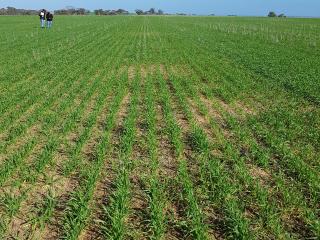Rhizoctonia bare patches are becoming noticeable
- Goomalling
- York
Rhizoctonia bare patches are present in consultant Tim Boyes (Agvivo) soils constraints trial sites at Goomalling and York. At both trial sites the tillage interventions appear to be suppressing the rhizoctonia activity as no rhizoctonia symptoms were noted in the renovated trial plots. The trials are investigating a range of tillage interventions.

At Goomalling the trial has been sown to Scepter wheat on the 13 May. The paddock has had a pasture (2016), wheat (2017) and wheat (2018) rotation and is a deep yellow sand. The rhizoctonia bare patches are noticeably present in the high traffic and untreated control strips.

At the York trial site the paddock has been commercially sown to Spartacus wheat on 26 May. The plants are at mid to late tillering. The paddock has had long term cereal rotations and is a non-wetting sandy gravel. The rhizoctonia bare patches are once again showing up in the high traffic strips and untreated controls.
Rhizoctonia root rot is a widespread root disease caused by a soil-borne fungus.

In the paddock look for severely stunted plants that occur in patches and there is usually a distinct edge between diseased and healthy plants. Roots of affected plants are short with characteristic pinched ends: ‘spear tips’ (see photo above).
Growers are urged to identify the causal agent/s of any cereal crops with patching or uneven growth.
Distinct patches are often evident when the primary roots of plants are infected early, while infection of the crown roots later in the season may cause an uneven crop. It is important to be aware that patches are not unique to rhizoctonia. There are other diseases including root lesion nematodes (RLN) and take-all as well as non-disease issues that can cause them. In particular, patches caused by rhizoctonia or RLN are difficult to distinguish without close inspection of the plant roots and often require further laboratory tests to isolate rhizoctonia or extract any nematodes.
There is nothing that can be done in season to control root diseases. An application of nitrogen post-sowing may aid recovery, but does not prevent root damage. Plant pathologist Daniel Huberli says that before the next crop is planted, it is important that the disease or issue causing the patches is confirmed in order to put the right management plan in place for 2019.
For diagnosis of root disease or nematode problems in-crop, carefully dig up symptomatic plants from the edge of the patch (not the centre) as well as healthy plants from outside the patches. The department’s YouTube video How to take a plant sample shows the correct method to use. Plants can be sent to the department’s Diagnostic Laboratory Services, Department of Primary Industries and Development, Reply Paid 83377, 3 Baron-Hay Court, South Perth WA 6151.
Keeping disease inoculum levels at low levels is the most effective way to minimise crop losses from root diseases and this can be achieved by thinking long-term and implementing management practices over more than one cropping season.
If you have confirmed your paddock has rhizoctonia with large amounts of the crop affected this year, the best option would be to place the paddock into a grass-free break crop in 2019, such as canola, pulse or pasture. Canola has been shown to reduce the level of disease in the following cereal crop.
For detailed information about management options for rhizoctonia read the GRDC's Tips and Tactics Rhizoctonia factsheet.
For more information and pictures of disease symptoms refer to the department’s;
- Diagnosing rhizoctonia root rot in cereals page
- Root disease under intensive cereal production systems page
- Rhizoctonia in your paddocks YouTube video.
For more information contact Daniel Hüberli, Plant Pathologist, South Perth on +61 (0)8 9368 3836 or Sarah Collins, Senior Nematologist, South Perth on +61 (0)8 9368 3612.

